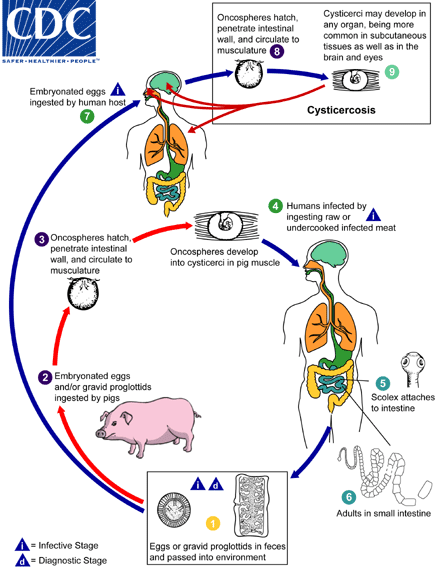Archive for the ‘Neurocysticercosis’ Category
A Case of Neurocysticercosis
Saturday, March 30th, 2019Disseminated Cysticercosis
- Nishanth Dev, M.D.,
- and S. Zafar Abbas, M.D.
March 28, 2019
N Engl J Med 2019; 380:1267
DOI: 10.1056/NEJMicm1810953
An 18-year-old man presented…..generalized tonic–clonic seizures. His parents reported that he had been having pain in the right groin for 1 week. On physical examination, the patient was confused. He had swelling over the right eye and tenderness in the right testis. Magnetic resonance imaging of the head showed numerous well-defined cystic lesions throughout the cerebral cortex and the brain stem and cerebellum that were consistent with neurocysticercosis……. Despite treatment with dexamethasone and antiepileptic medications, the patient died 2 weeks later.


Cysticercosis is an infection of both humans and pigs with the larval stages of the parasitic cestode, Taenia solium. This infection is caused by ingestion of eggs shed in the feces of a human tapeworm carrier
. Pigs and humans become infected by ingesting eggs or gravid proglottids
,
. Humans are infected either by ingestion of food contaminated with feces, or by autoinfection. In the latter case, a human infected with adult T. solium can ingest eggs produced by that tapeworm, either through fecal contamination or, possibly, from proglottids carried into the stomach by reverse peristalsis. Once eggs are ingested, oncospheres hatch in the intestine
,
invade the intestinal wall, and migrate to striated muscles, as well as the brain, liver, and other tissues, where they develop into cysticerci
. In humans, cysts can cause serious sequellae if they localize in the brain, resulting in neurocysticercosis. The parasite life cycle is completed, resulting in human tapeworm infection, when humans ingest undercooked pork containing cysticerci
. Cysts evaginate and attach to the small intestine by their scolex
. Adult tapeworms develop, (up to 2 to 7 m in length and produce less than 1000 proglottids, each with approximately 50,000 eggs) and reside in the small intestine for years
.

